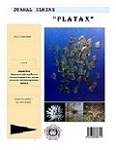Shell Color Classification And Carotenoid Pigments On Littoraria pallescens (Philippi, 1846) From Mangrove Ecosystem Area On Mokupa Village, Tombariri Sub District and Basaan Village, Ratatotok Sub District)
DOI:
https://doi.org/10.35800/jip.6.2.2018.20650Abstract
The purpose of this study was to classify the color of the shell and to know the carotenoid pigment content in Littoraria pallescens based on color classification and population distribution in the mangrove ecosystem area of Mokupa Village, Tombariri Sub district and Basaan Village, Ratatotok Sub district. Sampling directly on mangrove trees as water begins to recede. Identification of L. pallescens species is done by looking at the shape of the shell, the color of the shell, the color of the operculum and the shape of the genital organ. Shell color classification by inserting into the Color Explorer application. Analysis of carotenoid pigments by extraction process with acetone and petroleum ether, further separation of pigment by thin layer chromatography. The results obtained show that L. pallescence dominates life on mangrove trees. Sex was inversely proportional to the two research sites, 53.8% of the male L. pallescens species and 46.2% female in Mokupa waters while from Basaan waters there were 47.1% males and 52.9% females. Color classification based on the percentage of occurrences of constant color that is black (18.5), black orange (16.3) brown black spots (16,3), gray (10.7), angry (6,3), yellow pale (17.8), brown yellow spots (14,1). The detected pigment based on the color classification of the shell is located on the identical and identifiable Rf for all colors is the β-carotene pigment.
Keyword : Littoraria pallescence, Carotenoid pigments
Â
Tujuan dari penelitian ini adalah untuk mengklasifikasikan warna cangkang dan mengetahui kandungan pigmen karotenoid pada Littoraria pallescens berdasarkan klasifikasi warna dan sebaran populasinya di wilayah ekosistem mangrove Desa Mokupa kecamatan Tombariri dan Desa Basaan Kecamatan Ratatotok. Pengambilan sampel secara langsung pada pohon mangrove saat air mulai surut. Identifikasi spesies L. pallescens dilakukan dengan melihat bentuk cangkang, warna cangkang, warna operculum dan bentuk organ genital. Pendataan untuk klasifikasi warna cangkang dengan memasukkan ke dalam aplikasi Color Explorer. Analisis pigmen karotenoid melalui proses ekstraksi dengan aseton dan petroleum eter, selanjutnya pemisahan awal pigmen dengan kromatografi lapis tipis. Hasil yang diperoleh menunjukan bahwa L. pallescence mendominasi hidup pada pohon mangrove. Jenis kelamin berbanding terbalik pada dua lokasi penelitian, spesies L. pallescens jantan 53.8% dan betina 46.2% di perairan Mokupa sedangkan dari perairan Basaan terdapat 47.1% jantan dan 52.9% betina. Klasifikasi warna berdasarkan persentase kemunculan warna yang konstan yaitu warna hitam (18,5), hitam oranye (16,3) coklat bercak hitam (16,3), abu-abu (10,7), Marah (6,3), kuning pucat (17,8), kuning bercak coklat (14,1). Pigmen yang terdeteksi berdasarkan klasifikasi warna pada cangkang adalah berada pada Rf yang sama dan yang dapat diidentifikasi untuk semua warna adalah pigmen ß-karoten.
Kata kunci : Littoraria pallescence, Pigmen KarotenoidDownloads
Published
How to Cite
Issue
Section
License
COPYRIGHT
Authors who publish with this journal agree to the following terms:
Authors hold their copyright and grant this journal the privilege of first publication, with the work simultaneously licensed under a Creative Commons Attribution License that permits others to impart the work with an acknowledgment of the work's origin and initial publication by this journal.
Authors can enter into separate or additional contractual arrangements for the non-exclusive distribution of the journal's published version of the work (for example, post it to an institutional repository or publish it in a book), with an acknowledgment of its underlying publication in this journal.
Authors are permitted and encouraged to post their work online (for example, in institutional repositories or on their website) as it can lead to productive exchanges, as well as earlier and greater citation of the published work (See The Effect of Open Access).




















